Microsoft Surface Pro Review
by Anand Lal Shimpi on February 5, 2013 9:00 PM ESTDisplay: Awesome if Calibrated
Surface RT used a 10.6-inch 1366 x 768 display, for Surface Pro Microsoft integrated a full 1920 x 1080 panel of the same size. The increase in resolution is appreciable and you definitely notice it when switching between the two Surface models. Pixel density isn’t class leading, but it’s at least in the right range. On the desktop, Microsoft enables 150% DPI scaling by default which makes everything legible but still a bit odd in applications that don't deal well with fractional DPI scaling. Ideally I would've liked to have seen a clean doubling to avoid this mess.
The higher res display just makes everything sharper in the modern UI, and the 150% DPI scaling in desktop mode makes everything big enough where the higher res isn't a problem there. It's only in those desktop applications that don't properly implement Windows DPI scaling where the higher resolution is a hindrance. I actually ran into this problem using Chrome on the desktop, where my taps wouldn't always map to the right parts of the application (not to mention that Chrome in DPI scaled Windows looks terrible). Thankfully there is always the pen...
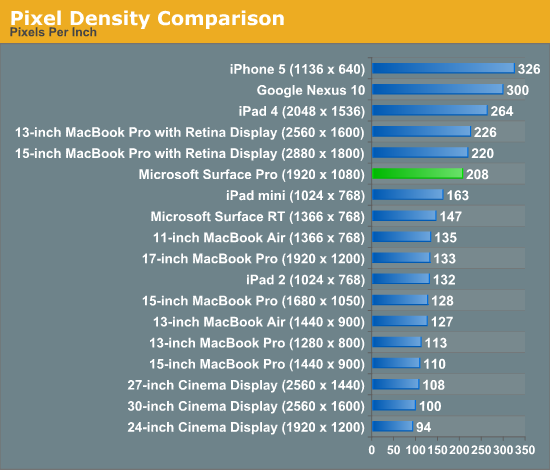
Once again Microsoft doesn’t do any substantial color calibration at the factory, but unlike on Surface RT you can run your own Windows display calibration software on Surface Pro to improve color accuracy if you have the right equipment.
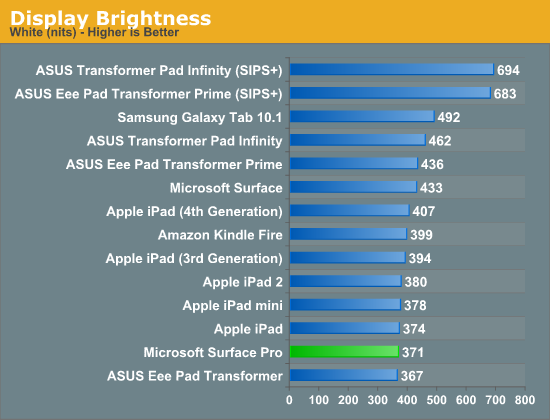
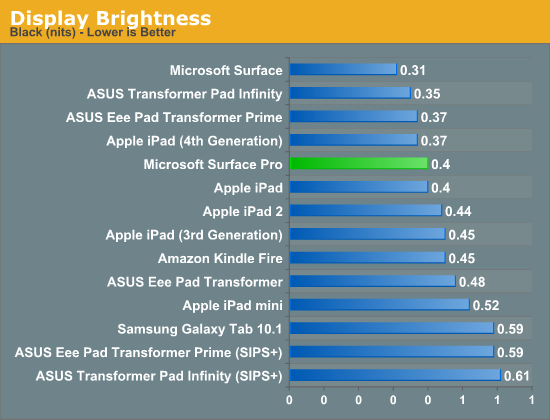
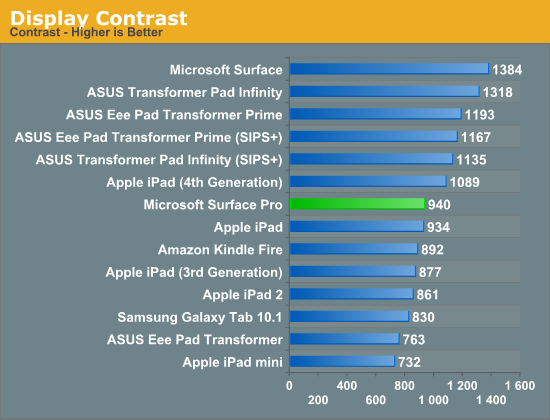
Out of the box my Surface Pro sample had an unusually high white point (~7500K), which negatively impacted its grayscale accuracy. To evaluate color accuracy I turned to our own Chris Heinonen's CalMAN smartphone/tablet workflow. Color accuracy is near identical to Surface RT, which is to say that it’s ok compared to PC notebooks from a couple of years ago but still far behind what you get out of the box from Apple.
Given that the majority of users don’t do any color calibration on their PCs, this becomes a real problem for consumer perception if your tablet doesn’t ship with accurate colors by default.
To see what the panel is capable of I ran it through our standard PC display calibration routine (which I can do since it’s running Windows 8 and is effectively a PC). I then re-ran it through our CalMAN smartphone/tablet workflow and ended up with much more pleasing results. While the display still lagged behind the iPad in one of the tests, it bested Apple’s Retina Display in the other two color accuracy benchmarks.
We'll start off by looking at the calibrated white point for these tablets. What you're looking for here is a number close to 6500K:
The next three charts look at accuracy represented as a difference between various source colors and what's reproduced on the display. The results are presented as average dE2000, with lower numbers being better.
First up is Grayscale performance, here we're looking at the accuracy of black, white and 19 shades of gray spread in between the two extremes:
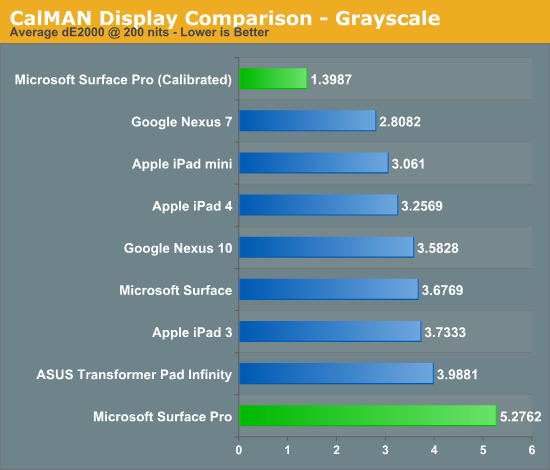
Out of the box grayscale performance is abysmal on Surface Pro. Calibrated accuracy, on the other hand, is just awesome.
First in our color accuracy tests is a saturation sweep. Here we're looking at 20%, 40%, 60%, 80% and 100% saturations of red, blue, green, magenta, yellow and cyan.
Our saturation sweep is the only test where even a calibrated Surface Pro can't match the iPad, it does do a lot better than Surface Pro without any color calibration however. Out of the box Surface Pro is considerably worse than any Apple tablet.
Gamut CIE Chart

Saturation CIE Chart
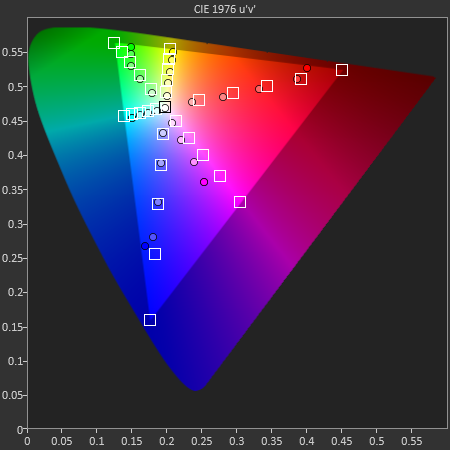
For our final accuracy test we're looking at the difference between a Gretag Macbeth colorchecker chart and the rendered swatches on these displays. Once again, lower numbers are better.
Out of the box Surface Pro and Surface RT are near identical here, and similar to the Nexus 10. With a good suite of calibration tools and supported hardware under Windows 8, Surface Pro has the potential to easily outperform the iPad if given the opportunity.
GMB Color Checker
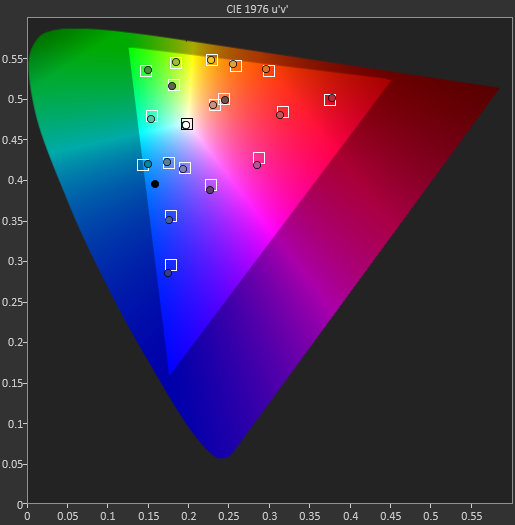
Surface Pro’s panel has real potential, it just needs a calibration pass - which is honestly something Microsoft should be doing these days, not the end user.
Mini DisplayPort but No Thunderbolt
Surface RT featured a single video output in the form of a micro HDMI port. Surface Pro adopts a mini DisplayPort output instead, and will have adapters to enable DVI and HDMI support.
The miniDP output immediately activates as soon as you plug a display into it. I sometimes had issues with display resolutions being set sub optimally, but generally speaking the process was as plug and play as you can get.
I did notice some visual tearing on the Surface Pro display when connected to an external HDMI monitor, similar to what I saw with Surface RT but not nearly as bad. I’m beginning to think something is a bit wonky with Windows 8’s multi-monitor support. What’s interesting is I didn’t see the issue on all displays, which is more than I can say for Surface RT. Update: It looks like this is hardware related. Even if the internal and external panels have the same refresh rate, Intel's HD 4000 won't guarantee that the refreshes will happen at the same time - which is why we see tearing. The tearing should only be present in clone mode, not extended desktop (I'll verify this shortly). It seems like Tegra 3 is worse in this regard, which is why the issue was so much more prevalent on Surface RT. I need to check other Ivy Bridge platforms and under OS X to see if the problem is as prevalent there as well.
The only disappointment here is Microsoft opted against integrating Thunderbolt into Surface Pro. I feel like Thunderbolt would’ve made a ton of sense in a device like Surface Pro, enabling one cable connection to both an external display and high-speed external storage. Given that Thunderbolt adoption remains fairly limited in the PC space I don’t think this is a huge loss for most of Microsoft’s target customer base, but I do feel like it’d be a good way of future proofing the device. The alternative that Surface Pro offers is the combination of miniDP and USB 3.0, which realistically speaking is probably good enough for most users. From a cost of integration standpoint vs. the number of users who would pay for it, it probably didn’t make sense for Microsoft to include Thunderbolt in Surface Pro, but that doesn’t change the fact that I wish it was there. It’d be nice for Apple not to be the only company really pushing Thunderbolt.
Camera Quality
Surface Pro, like Surface RT before it, features two integrated 720p cameras with no flash. Admittedly I didn't spend a ton of time taking photos with Surface Pro but imaging quality is just really bad compared to what you'll get out of an iPad 4. The results are borderline ok for use on the web but that's pretty much it, and forget about decent low light performance.


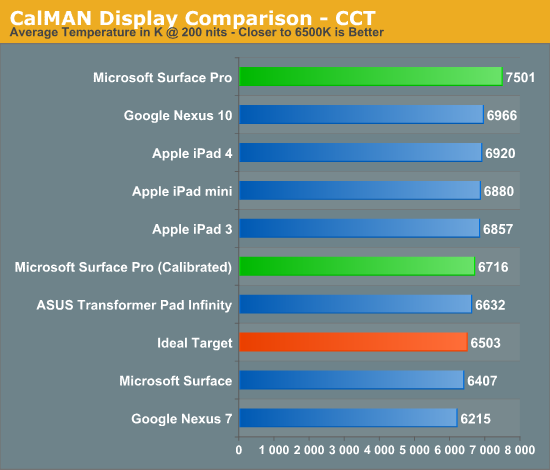
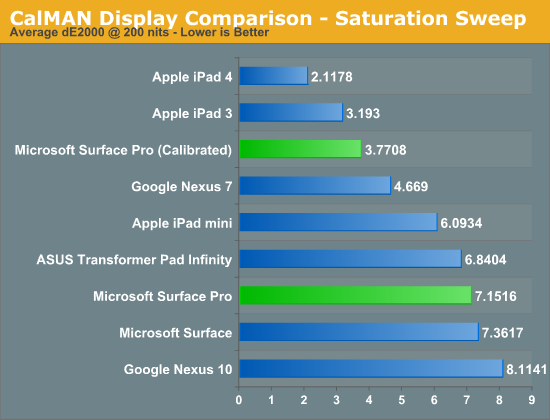
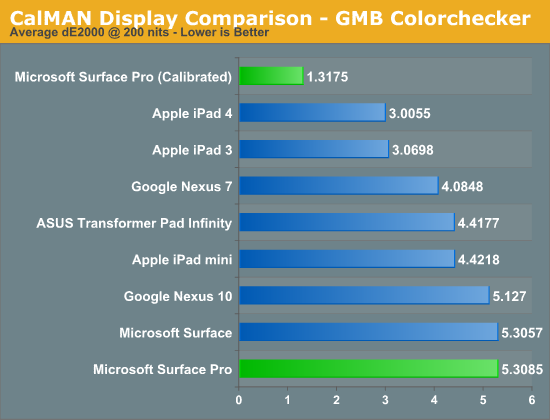










228 Comments
View All Comments
HoushaSen - Friday, February 8, 2013 - link
Aside from the weight (1.8 lbs), the lenovo's upcoming Core hybrid tablet/ultrabook have one major advantage, which is the battery life. To be honest, 1.8lbs vs. 2.0lbs won't make a difference for me as anything over 1.5 lbs is just not comfortable to hold in one hand i.e. either way it won't work as pure tablet for me.So the true major benefit of getting Helix over the Surface Pro for me was the battery life. Despite both system having the identical battery capacity (42W), Lenovo claims 10 hours battery life because it has the battery equipped keyboard dock.
If MS truly releases one for Surface Pro, and obviously for the reasonable price I think the advantage of Helix goes away (remeber helix starts at $1499).
Plus when MS is designing this new keyboard, I hope they have also put lap friendly design for consideration as well to solve that issue.
But since battery life has been listed as one of the major downside of this device everywhere, I think MS should simply announce the dock on its way officially to at least make most people believe there is a way to extend battery life. Anyways, this is just my opinion.
Jaerba - Friday, February 8, 2013 - link
They teased the hell out of a battery keyboard dock during their AMA, so I expect it's on its way. I just wish they'd 100% confirm it and give a date.Really, a keyboard dock could solve three of its major problems (battery life, multiple viewing positions and keyboard quality.) You'd really just have the text scaling issue as the one major gripe.
IUU - Saturday, February 9, 2013 - link
So you get a computing device that is 5 times to more than an order of magnitude powerful compared to arm devices and still getting half the battery life, for not quite double the price?Not taking into consiferation that the next generation of Intel's processors will be significantly more efficient?
Being able to run any x86(legacy ... lol) program without relying on an "app" store?
Being able to expand and transfer memory any way you want, even managing to run demanding desktop programs, even though a bit slower than a desktop?
Sounds like a pretty good deal to me(compared to arm offerings), though something normal and expected in the pc world!
Tams80 - Saturday, February 9, 2013 - link
It looks good, but I think the Thinkpad Helix will probably be a better option when it's released, even though it will be more expensive. For someone like me, this would be a considerable purchase no matter what, so I'm more than prepared to pay more. The Fujitsu Q702 could be contender, but the display resolution is poor and the Sony Duo 11 is tempting, but is not a dock tablet and has limited keyboard space.My ideal tablet PC is a pipe dream.
-Something like the Fujitsu T902, but being a dockable/detachable, with a swivel 'docking bracket''.
-Ideally a dGPU - an AMD APU (with -G graphics) paired with AMD -M graphics in hybrid crossfire. The dGPU would be in the dock.
-mSata SSD in the tablet/lid
-HHD/SSD in dock
-modular bay in dock
-Anytime USB charge on at least two USB ports
-USB 3.0 ports, one/two on tablet, at least two on dock
-LightPeak/Thunderbolt/whatever that mess seems to be doing
-Active digitiser - Wacom Penabled still appears to be the best
-SD/other card reader
-large trackpad on dock with physical buttons
-13.3 display
-1920x1200 display (or double that resolution)
-ample bezel buttons
-at least acceptable speakers
-1080p webcam, or whatever the marketing term used now is
-some decent microphones
-trackpoint/whatever other companies call it?
-ExpressCard? Is there an updated version?
-not sure about a rear camera - rather pointless on such a device
Yeah. That's never going to happen.
topdomino - Saturday, February 9, 2013 - link
In december, you called the Dell XPS 12 "the coolest ultrabook around" and mentioned that fliping the screen creates a tablet.http://www.anandtech.com/show/6510/holiday-2012-ul...
Given that the specs on the 128 GB Surface Pro and the current base model of the Dell XPS 12 are so similar:
Surface Pro: 1.6GHz base clock, 4 GB Ram @ 1600MHz, Intel HD 4000 graphics, 128 GB SSD, $1,128 (with Type cover);
Dell XPS 12: 1.7GHz base clock, 4 GB Ram @ 1333MHz, Intel HD 4000 graphics, 128 GB SSD, $1,199 (comes with keyboard);
I would have expected a direct comparison between them to be the most useful one.
bogieworf - Saturday, February 9, 2013 - link
Comes down to whether you want a PC that is more like a tablet or a laptop. That smaller dimensions of the Pro are simply more tablet like, Of the two, the XPS is probably the better bet right now.Because it is convertible size, it has fewer tablet like demansd made of it. For example, I never heard of the XPS 12 being slammed for battery life like the Pro because the XPS battery life is in line with most convertibles on the market. The larger size also allows for a better keyboard. It also has a wider, and more convertible like array of specs.
The Pro is tablet size and people expect it to perform like a tablet. Unfortunately, that requires Haswell and probably a cellular option as well. Both will probably come with the Pro 2.
Death666Angel - Sunday, February 10, 2013 - link
All I read there is "cater to the stupidest among us". The XPS12 looks less like a tablet so less people will expect it to behave like a tablet as opposed to the Surface Pro? How brain damaged should we expect consumer to be?Actually, pretty brain damaged if I go by most reviews, which treat the Surface Pro as an iPad competitor and rank it accordingly. It boggled my mind.
damianrobertjones - Saturday, February 9, 2013 - link
How come none of them appeared in the battery life section? They actually, in some cases, destroy the competion in performance and battery life?Death666Angel - Sunday, February 10, 2013 - link
How would an Atom powered anything destroy a Core i-5 powered anything (or anything that is above a Celeron really)? Battery life? Sure. But what good is 6 hours of continuous use when you have to limit what you actually can do with it vs. 3 to 4 hours of continuous use without limits? If you need the battery life and don't need the performance, the choice is clear. And vice versa. :)I would have liked to see a comparison with the Samsung XE700T and the Acer W700 (which is perfect except for lacking a digitizer). But I can understand that they don't have everything.
lmcd - Sunday, February 10, 2013 - link
but I'm more interested in what happens when Google puts out a better version of their Chrome mobile browser. As noted, the Nexus 10 wasn't that horribly off from the Surface Pro, and I think with some OS optimization (or replacement with a nice KDE Plasma Active setup :-) a Nexus 10 + keyboard dock of some kind would knock out the Surface Pro and RT in one shot.